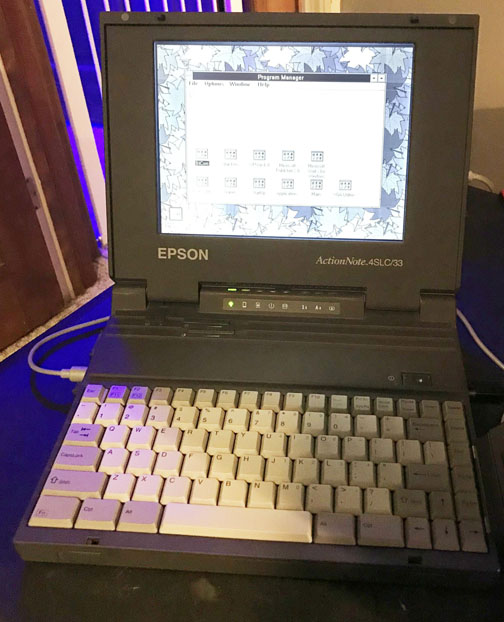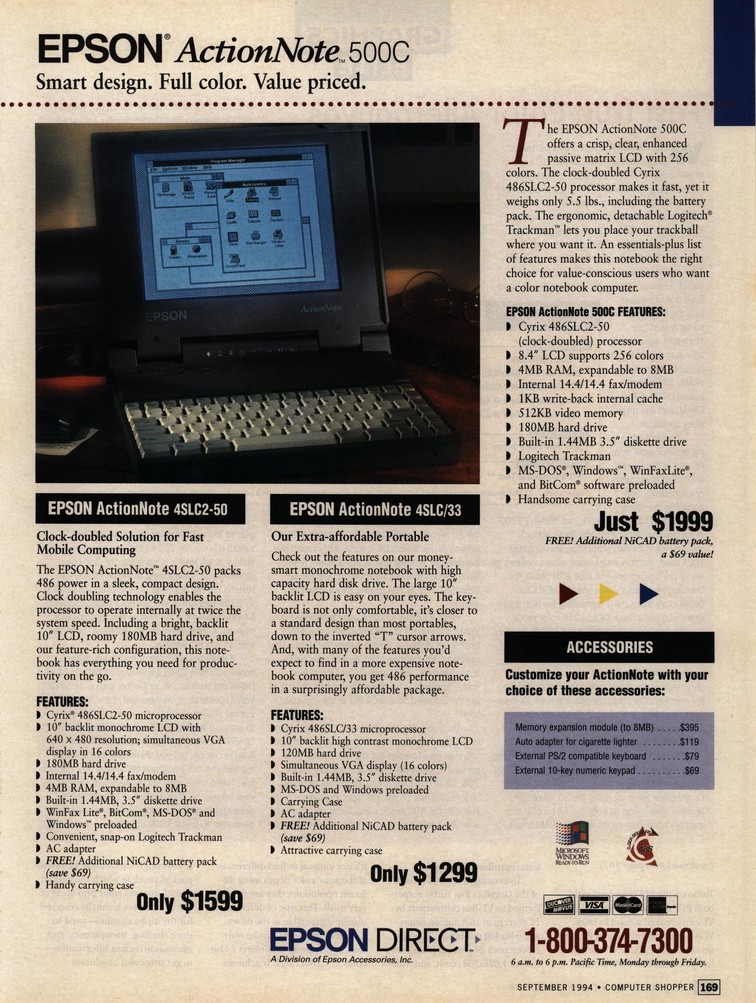
Epson ActionNote 4SLC/25, 4SLC/33, and 4SLC2/50
The ActionNote SLC Series were fairly utilitarian lower-end 486 laptops, released through 1993/1994. They share the same case as the color 500C model, and the 4SLC2/50 should in theory literally just be a 500C with a grayscale display.
These laptops were manufactured by ASE Technologies, the same company that manufactured the WinBook XP and XP5. It is unclear whether these were designed by ASE, or if they only manufactured them.
Specifications
| Spec | Details |
|---|---|
| CPU | CPU Type: Soldered QFP - Cyrix Cx486SLC @25 or 33MHz - 486SLC2 @50MHz |
| Chipset | Unknown |
| RAM | Type: Proprietary Standard: Unknown Maximum: 8MB |
| Hard Disk | 2.5" IDE Uses proprietary adapter?: Unknown Standard: Unknown |
| Display Options | Passive Matrix Grayscale @640x480 |
| Graphics Chipset | Unknown VRAM: Unknown |
| Audio | PC Speaker |
| Main Battery | Unknown |
| CMOS Battery | Dallas Integrated RTC/Battery |
| Power Supply | Kycon KPPX-4P Connector |
| Disk Drives | 1.44MB 3.5" Floppy Drive |
| PC Cards | Unknown |
| Other I/O | Unknown |
| BIOS | AMI |
| Pointing Device | None |
Common Faults & Maintenance
Dallas RTC Chip/Battery
These ActionNotes use the infamous Dallas chip for RTC/CMOS Battery functions. This chip is an integrated real time clock/battery solution that was very common on desktop boards of the time, and these laptops have them as well. This chip is a small black module that has an integrated and non-replaceable battery inside. This battery thankfully doesn't leak, but when it goes dead, you can't replace it. What's worse, many computers that used this chip needed the battery to be good for the computer to boot properly. These ActionNote laptops do in fact need the battery to be good to boot properly. I currently do not have a guide up on this (you can easily look one up though), but it is possible to hack a new battery onto the chip. This involves grinding down the chip until the battery contacts inside can be exposed and disconnected. You'd then solder wires to them that go to an external battery holder. Again, I'd recommend looking up a guide on doing this.
Other Notes
Beyond these two fixable faults, these laptops are reported to be quite reliable. You may be wondering about brittle plastic and hinge issues. I have not handled these myself, but compaqportableplus, who originally documented these laptops, says that the plastic quality on these is actually pretty good and that hinge failures don't seem to be an issue.
The main battery is either going to be NiCad or NiMH, both of which are very prone to leaking. Keep them out during storage if they haven't leaked already.
The finish on the plastics seems to be a bit easy to scratch.
As noted in the specs list, the RAM for these systems is proprietary. If you need more than what a unit you're buying comes with (4MB soldered), don't expect to be able to find any upgrades that don't come from another complete unit.
Thee 500C (not sure about these models) uses a proprietary 4-pin PSU connector, similar or maybe even the same style as the original 486 WinBooks. This would normally make sourcing a supply difficult, however, there is currently a seller on eBay who has over 2 dozen of them in stock. For the time being, they aren't hard to find. If you see this page hasn't been updated in years though, things may be different.
Gallery
Click on any image below to view the full-size version of it.
Provided by compaqportableplus on the VCF forums. Thank you!

ActionNote 4SLC/33, powered on.
Print Ads

Page last updated (MM/DD/YYYY): 01/01/2025
Update Reason: added print ad
Back-Navigation
Home < Laptop Portal < Epson < ActionNote SLC Series